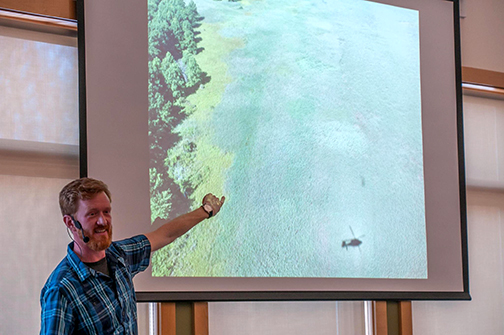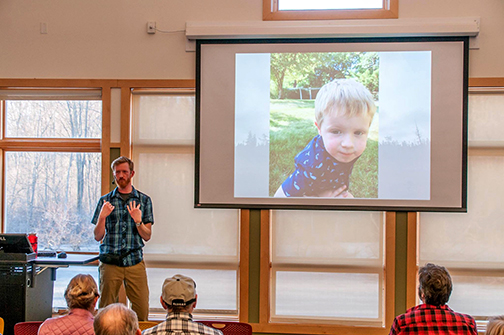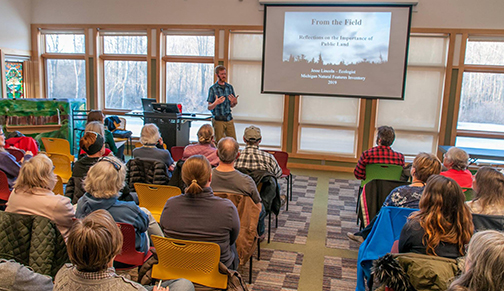
March Meeting Recap
Compiled by Ruth Oldenburg
From the Field: Reflections on the Importance of Public Land
Presented by Jesse Lincoln, Michigan Natural Resources Inventory (MNFI)
Wild Ones and guests were treated to a presentation by Jesse Lincoln, an ecologist from MNFI on March 18.
Jesse reflected on his 3 year old son, “How do I develop his value system,” in particular towards nature.
He showed a slide of Lake St. Clair completely covered with the invasive plant Phragmites. Yet, unspoiled communities do exist in Michigan—for in example Marquette and Drummond Island.
MNFI’s mission is: “To guide the conservation of Michigan’s biodiversity by providing the highest quality scientific expertise and information.”Their vision is “To be the authoritative source of information on biodiversity that is widely used to conserve Michigan’s unique natural heritage for current and future generations.”
MNFI is headed by Michigan State University but is funded by The Dept. of Natural Resources. (DNR)
In his work, Jesse uses circa 1800 maps created by the General Land Office. The early surveyors divided the state in to townships, marking 4 trees on each corner. He showed us a circa 1800 map of the Lower Peninsula. On MNFI’s website you can download an 1800 map of your county and the website will soon have the state map available for download.
Link for circa 1800 Kent County map.
Natural Communities are made up of complex describable components. MNFI looks at soils, landforms, ecological processes, and threats.
MNFI Documenting:
Rating – how good is it?
- Size
- Condition (invasive sp., anthropogenic disturbance)
- Landscape rank
- Overall rank
Description
- Canopy composition and structure
- Tree size and age
- Understory shrubs
- Herbaceous vegetation
Jesse feels so lucky to work for MNFI as he gets an encompassing look at Michigan.
So how can he teach his son?
- Take him to public land.
- Teach him the narrative.
- Help him understand. (People care if they understand.)
- Help him make a connection. (People care if they have a connection.)
The DNR set aside 400,000 acres in the 60s to preserve the land and so people could have hunting areas. Jesse’s job is to survey Michigan’s public lands and inventory them.
How is the inventory done?
- Dividing the land according to texture using aerial photographs.
- Walking each section
- Recording what is there
- Making recommendations
Understanding a site’s narrative guides him where to prioritize.
Jesse made an example of the Muskegon River floodplains. He described it as “hellish land”—deer dying of Ebola, stinging nettle rampant, elm and ash borer damage—but it is also beautiful and sequesters nutrients. The area has Oak-Pine Barrens and Wild Lupine, the host plant of the Karner Blue Butterfly.
How to convince the DNR to manage this area?
- Improve habitat and for turkey hunting
- Courtship and displaying sites for woodcock
- Grass, forb and brush components found in area
- Savanna edges will provide habitat for eastern cottontail rabbits.
Another example is Lake Erie’s algae bloom crisis. Non-native mussels change the competition of bacteria in the shallow (up to 8 ft.) water. Big agriculture is poisoning the water with ditches that speed up the water before it can be filtered naturally.
Public land helps protect the Great Lakes. Politics have affected land management. Goal needs to be preservation of public lands—hunters and non-hunters need to partner to preserve the last vestiges of true nature.
Solutions:
- Create a recreation-use passport
- Honor the intend of DNR land – hunting
- Form an education network
- Celebrate hunting
- Reach out to inner city youth
- Anchor people to a place
Parting thoughts from Jesse:
- Develop a new political party with a eco-centric agenda
- Decision-making should be shaped by watersheds
- Dis-incentivize sprawl
- Perverse incentive to expand government and deplete native cover via expanding tax base.
We thank Jesse for his thought-provoking presentation! His son has a good teacher who will undoubtedly instill in him the love of nature and the land.
To read more about Michigan Natural Features Inventory visit mnfi.anr.msu.edu



